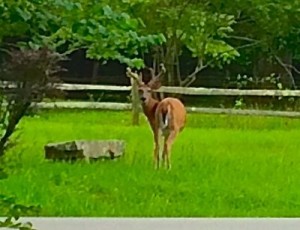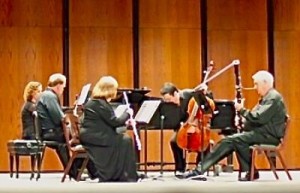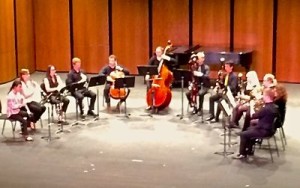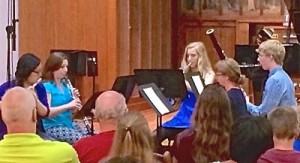The Final Two Weeks in Sewanee, Tennessee

Wildlife in Sewanee
The University of the South in Sewanee, Tennessee has southern roots going back to the 1860s. There’s a slow pace and gentle rhythm to everyday life on this hilltop town. The grave sites of Confederate soldiers can be spotted in the cemetery I walk by on a daily basis. The slow and light traffic on campus allows for the sounds of nature to come through. Songbirds in the morning, musicians during the day and cicadas and croaking frogs at night give this small community their signature sound. There’s a wind that hits the leaves of the tallest trees that makes it sound like rain, even when the skies are clear. Carilloners perform recitals several times during the Sewanee Summer Music Festival, and at the beginning of the month, an all-girl bluegrass band took time out to entertain those dining in the 1,000-seat cafeteria. When I asked the Pierce brothers, Jim and Joe, two avid bird watchers if they could tell they were in Sewanee by just listening, they both replied “Yes”.
Besides the active birds in Sewanee, the campus mascot, who I call “Shaggs”, roams the area around the Stirling’s restaurant. Shaggs has a heavy coat that is usually wet from his walks in a nearby stream. His gray whiskers and happy spirit blend in with the timeless atmosphere. Pepe and Paco LePugh, two neighborhood skunks, patrol the bridge my students must cross on way to their lessons and studio class. Fortunately, I don’t hear about any students needing a tomato juice bath! Squirrels play “tag” between the giant trees and deer and bunny rabbits are a common sight. Fat bugs and a variety of colorful butterflies add to the Sewanee experience.
Sewanee, Tennessee has an unusual distinction. It is the only town in North America that is classified as a rain forest! Eight days with rain helped it live up to it’s reputation, and when it comes down it can be drenching. Timing your trips between buildings can be important. The weather app saved me several times!
The weather was good enough for the students to perform an outdoor concert at the Sewanee Inn and Country Club. My students, Katrina Kwantes and Jenna Sehmann, played beautifully in the Haydn Symphony No. 100. Haydn’s “Military” symphony takes on a special quality when the snare drum and tympani aren’t confined to the walls of a concert hall.

Bob Stephenson performing Telemann Taffelmusik
My own performances include the music of Georg Philipp Telemann, the Hindemith Woodwind Quintet and the Ludwig Thuille Sextet. The stage is hot, but the collaboration with my gifted colleagues is always fun. Someday we can look forward to the air-conditioner being fixed.
The studio class and summer experiment proves to be a big success. My twelve students are introduced to 21 points of musical expression and in front of several other faculty members they all perform in a convincing style. The woodwind faculty begins discussing an expanded version that we can use next summer. In a year my hope is that all the young musicians who play flute, oboe, clarinet and bassoon will have ideas about phrasing that will highlight their musicianship. I keep telling them “It has to be about more than just getting the notes!”
The oboes all went out for Mexican food at Mi Casa. The chips and salsa are worth the trip. Many of them have trouble “leaving work at the office”. There was plenty of talk about the oboe.
The class recital was another highpoint. Their performances contained some special moments. SSMF alumni, Wilson Harmon, returned to offer his keyboard skills. For two of the young oboists it was the first time they had ever played a solo in public!

Sewanee Oboe Class Recital
The student orchestras performed many works, including Symphonic Metamorphosis by Hindemith and Scheherazade by Rimsky-Korsakov. There is always that youthful enthusiasm and satisfaction in hearing them do well. I enjoyed reporting back to Lisa about her student from the University of Utah, Cindy Chen, who sailed through the Hindemith in expert fashion. It was nice to see and hear Memphis Symphony Music Director, Mei-Ann Chen, lead the Sewanee Symphony through a challenging program. The repertoire, which included Scheherazade, A Midsummer Night’s Dream by Mendelssohn and “Blue Cathedral” by Jennifer Higdon was played with precision and expression. Her leadership in conducting five concertos was especially good, and having a twelve year old cellist win the “competition” gives everyone hope for the future.

Students in Dvořák Serenade
The end of the festival means faculty, staff and students head off in every direction. My floor-mate, violinist Shi-Hwa Wang from Utah, heads to the Esterhazy Palace in Eisenstadt, Austria for an 18-day music festival. Because Lisa and I were there two months ago, I shared pictures on my iPhone that Shi-Hwa quickly identified. I tell him how jealous I am to be playing in a place where many of Haydn’s works were played for the first time! For a second year in a row, on the morning after the final concerts, I had a choice of any seat in the cafeteria. The cafeteria staff is very friendly, and since I never missed a meal, they got use to my bearded face. I tell them all “I’ll see you in eleven months!”

Flutist Cindy Chen and Oboist Jenna Sehmann in Sewanee Woodwind Quintet
Upon returning my tray I’m pretty sure I can hear a songbird announcing a new day. It’s that or a young piccolo player getting in a last session of practice before a flight home. Hopefully, the 180 students who called Sewanee home for four weeks leave this special place with an added dose of inspiration.
– Robert Stephenson and Lisa Byrnes
